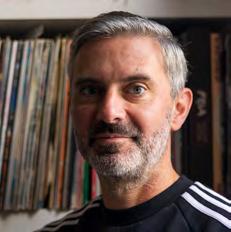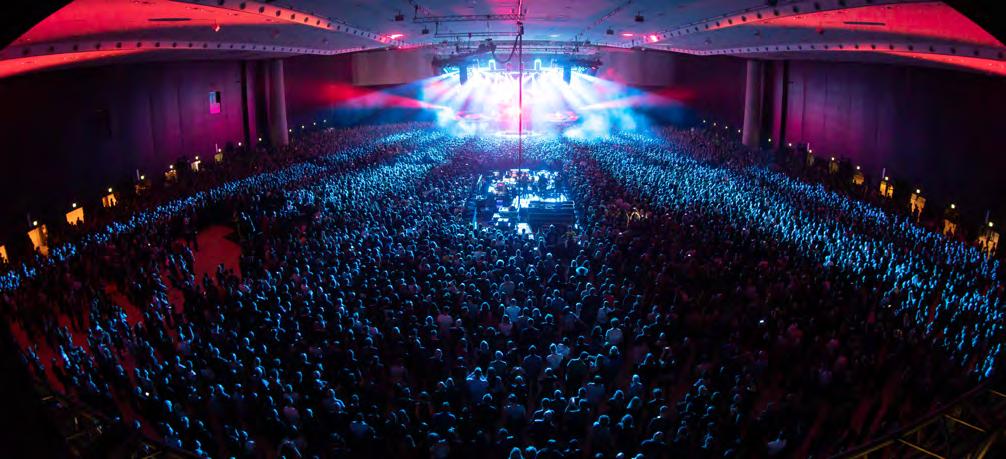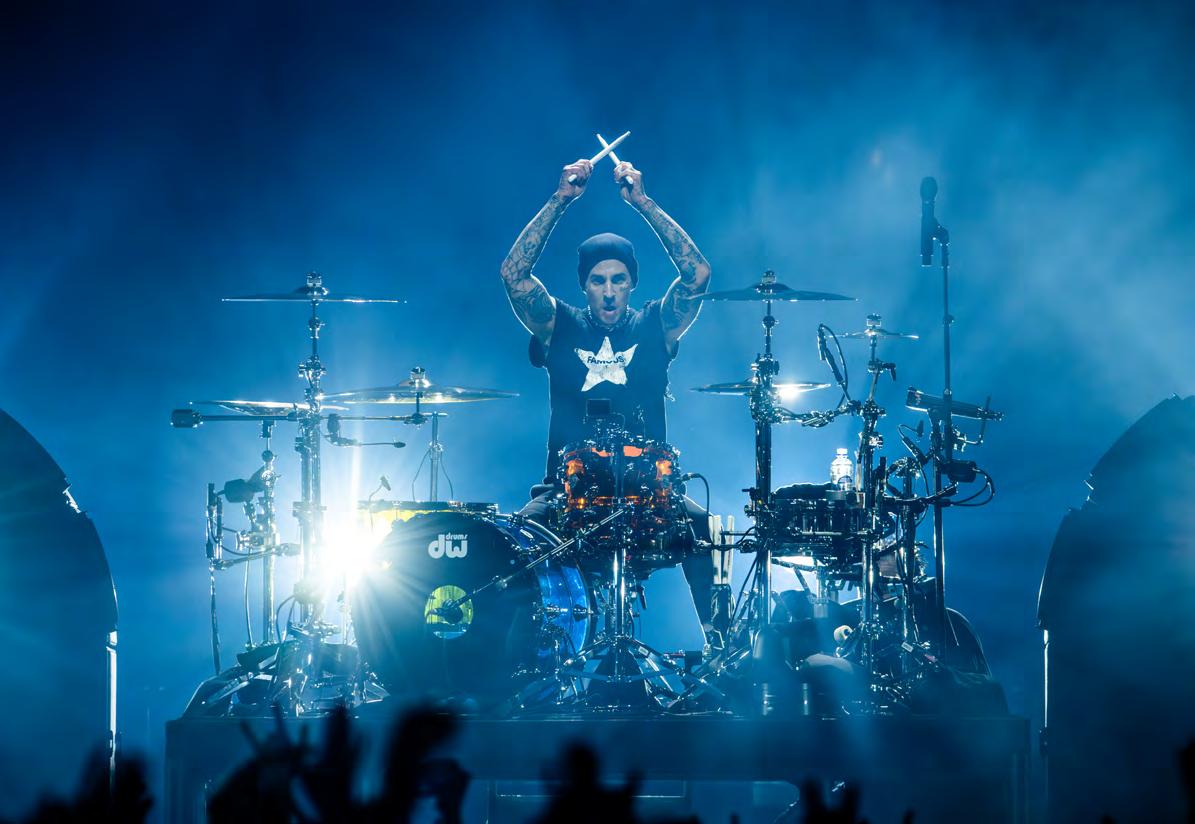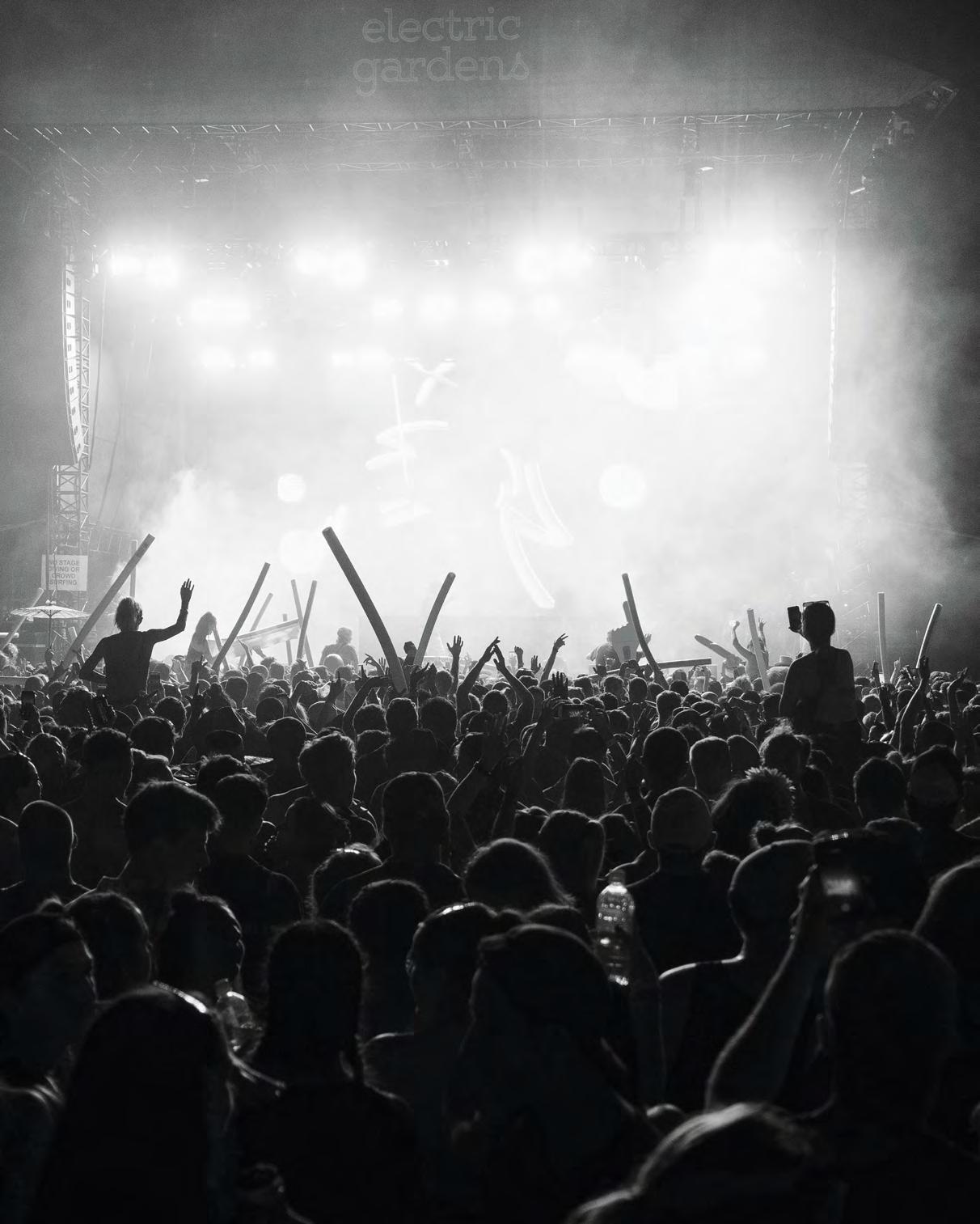Global Arena Guide

The definitive guide to arenas hosting live music and entertainment Arena fever
The new venues coming on stream soon
Going green Cutting-edge sustainability initiatives
69 Markets profiled
590+ Arena directory



The definitive guide to arenas hosting live music and entertainment Arena fever
The new venues coming on stream soon
Going green Cutting-edge sustainability initiatives
69 Markets profiled
590+ Arena directory


Sub-editor
Designer

Welcome to the fourth edition of the Global Arena Guide, our annual review of key markets for international touring acts at arena level.
It feels like there are more arena openings than ever this year, with exciting state-of-the-art buildings coming on stream the world over. And as we discover in our 69 in-depth market reports – covering every continent except Antarctica – the breadth of content filling the stages is growing, too.
And there are many more venues in the pipeline, as we explore in our special feature looking at forthcoming arenas (see page 10) around the globe.
Plus, we look at the latest innovations making the industry more sustainable, including a deep-dive behind the scenes at the world’s first carbon-removed concerts (see page 14).
And as well as deep and insightful explorations of the industry, the directory includes details of almost 600 arenas –vital information when planning tours.
I hope you find this biggest-ever edition of the Global Arena Guide useful. A lot of work goes into producing this publication, and I want to thank everyone involved, from all the arena staff who shared their insights with our journalists to all the companies and associations who have so generously supported it.
I’m always inspired by the creativity and resourcefulness of people working in this part of the industry, and it’s a privilege to share their hard work with you once again. I’d love to hear what you think of it – so don’t hesitate to contact me with any feedback or suggestions you have.
James Drury | Editor



Our recently published research for 2023 shows both attendance and number of events exceeding the pre-pandemic results of 2019. This is positive news for all our members and arenas across Europe and highlights the recovery of the live event market.
The positive results seen in 2023 were achieved despite inflationary pressures and economic uncertainty and can be largely attributed to our members' dedication to meeting the growing demands of customers by creating enhanced, value-added experiences and developing an engaged and well-trained workforce to deliver them.
Looking at our members’ activity, last year, music accounted for 48% of total events and 62% of total attendance, but we must also highlight that sport is an important component for many of our members, accounting for 24% of total events and 19% of total audiences.
The outlook for music in 2024 is strong, with high demand for international tours, and we are also seeing a robust market for national and local artists in our members’ respective countries. The appetite for sport remains healthy, particularly in the light of the major global events being hosted in Europe this year.
The EAA continues to develop initiatives focused on knowledge sharing, innovation, and networking across its membership platform, in addition to strengthening relations with EU governing bodies through activities that are aligned with current EU policies.
We are optimistic for 2024, as our members continue to work diligently to meet the evolving expectations of all our stakeholders and partners.
Olivier Toth | President, European Arenas Association (EAA)


Ongoing activity across the NAA focuses on a number of subjects that affect not just arenas but all venues.
We've ramped up our work on sustainability, working with A Greener Future towards a Green Rider for arenas (which will no doubt be useful for smaller venues as well). This builds on the good work done across the live industry to make our business as sustainable as possible.
Security is another major focus for us at all times, but especially now with the Terrorism (Protection of Premises) Bill going through UK Parliament. We are engaging with government departments via LIVE through our security working group to demonstrate our current security initiatives across the UK, and we are an active participant fully in the ongoing discussions about the Bill.
It's therefore very welcome that business was strong in 2023 and is in good shape looking forward, with fans demonstrating an appetite to enjoy live entertainment and to benefit once again from the very real mental health benefits that come with a good night out!
John Drury | Chair, National Arenas Association (NAA)
Population: 60.4million Language: German Currency: Euro (EUR) GDP per capita: $55,900 Internet users: 8.3million Active smartphones: 11.1million
In one of its first forays into mainland Europe, Oak View Group won the bid to construct a €384m, 20,000-capacity arena in Vienna. However, in October 2023, an Austrian court revoked the decision, leaving the “state-of-the-art” venue – initially scheduled to start construction next year – in limbo.
“This beautiful city has always been the jewel in Europe’s cultural landscape, but it had no arena to match it,” OVG boss Tim Leiweke said to Die Presse following the decision.
Bosses at the capital’s current arena, the 16,000-capacity Wiener Stadthalle, might disagree with Leiweke, as it continues its reign as Austria’s largest arena. The multipurpose space will host The National, Jonas Brothers, Kygo, and Billie Eilish over the next 12 months.
Outside Vienna, Austria has a number of multipurpose spaces, like Messe Congress Graz Betriebsgesellschaft in the nation’s second-largest city, Graz. The city hall and open-air arena portions of the eight-venue complex boast a combined capacity of over 35,000, with the indoor Stadthalle arena available to host 14,500 people.
Business is roaring back to pre-pandemic levels in many European markets and arenas are reporting fast sell-outs at the top end of the business. But economic struggles and a cost-of-living crisis mean that consumers are being more cautious with their spending, resulting in sluggish sales for mid-levels acts in many countries. Costs are also a concern for many arenas, which are working hard to control the price of staffing and energy. Nonetheless, across the continent, sustainability is a strong focus, as venues recognise that being more environmentally friendly also means cost savings. The future looks bright – but with a level of caution.
In 2023, the complex, dubbed “a one-stop store” by Christof Strimitzer, head of marketing and communications, hosted roughly 300 events and welcomed over 620,000 visitors. The desire for events is steadily growing for the venue’s patrons, he says, with entertainment options expanding past solely music.
“There has been a slow comeback, but we are now back to a good level. People are being more selective than before due to ticket prices but are generally spending money again to enjoy the live experience,” he says. “Family entertainment and sports segments are very much in demand.”
Over in Innsbruck, the 10,000-capacity Olympiahalle primarily functions as an ice hockey venue but will bring in Deep Purple and German rapper Ski Aggu later this year.



Population: 12million Languages: Dutch, French, German Currency: Euro (EUR) GDP per capita: $53,300
Internet users: 10.9million Active smartphones: 11.7million
Be•at Venues, a Live Nation Belgium subsidiary, has cornered the Belgian market with its expansive portfolio of four arenas and three theatres.
The facility group’s holdings include Antwerp’s big Sportpaleis (23,000), Hasselt’s multi-hall Trixxo Arena (17,000), Brussels’ concert hub Forest National (8,400), and Antwerp’s basketball home Lotto Arena (7,500).
Also nestled in Brussels, the former Palais 12, renamed ING Arena in September 2023, boasts a capacity of 15,000 and hosts a variety of local stars along with international tours. In the Flemish region of the country, Ghent’s 13,300-cap Flanders Expo serves as the space for conferences and fairs for a variety of sectors.
Mid-sized arena Forest National is due to continue renovation projects following its 30-year licence renewal. Be•at managing director Jan Van Esbroeck says it will begin updating the ventilation system and refreshing the backstage installations over summer 2024, adding to previously completed roof and sanitary block projects.
“We choose to close the venue during the summer period for several years in a row rather than one longer period,” Van Esbroeck says. “This way, we can provide maximum service to our promotors and fans. In Belgium, the summer months are mainly festival months. The other arenas get a proper refreshment during those same months.”
In the non-summer months, business is strong: both local and international midsize acts are plenty and selling well, which “gives artists opportunities to grow into the really big venues,” Van Esbroeck says. Last year, be•at sold a recordbreaking 2.75m tickets across its seven venues, with plans to exceed the number of events this year.
While business is at its peak, the success is not without challenges. Massive A-list tours are beginning to falter for Belgian stops, and cancellations are becoming an increasingly frequent hiccup in the execution of shows.
“Previously, you had absolute certainty with a confirmed date for an artist; this is now much less so,” Van Esbroeck says. “Confirmed shows are moved or even cancelled, and neither the agent, the artist, nor the promoter seems to want to bear any responsibility. Nevertheless, this is detrimental to the venue operator, as they have a demonstrable loss as a result of such a cancellation.
“A tightening of cancellation rules seems imminent.”
Nonetheless, a variety of music, sports, and entertainment is scheduled for the venues across the next year. At the Sportpaleis, Olivia Rodrigo will play two nights, and family horse spectacular Cavalluna will gallop into the venue. Hozier, Melanie Martinez, and Glass Animals will perform at Forest National, whose calendar also includes Riverdance, Swan Lake, and Disney On Ice.
At Lotto Arena, home of the Antwerp Giants basketball team, the calendar is split roughly three ways between music, sports, and family entertainment. And over at Trixxo Arena, bigger conferences and genre-specific events, like the annual Het Schlagerfestival, find a home. And despite an average ticket price increase of 15% across the board, Van Esbroeck says demand is higher than ever.
“We see no signs of weakening, although Belgian consumers are price-sensitive, and we notice that there are limits to ticket prices,” he says. “It is also a typically Belgian phenomenon that uplifts, packages, and premium seats are comparatively less sought-after than in the US and also our neighbouring countries.”
Sandwiched between France, the Netherlands, and Germany, a variety of languages and dialects are spoken across the country. Programming is reflective of this, with regional and national artists of all backgrounds performing across the arena circuit – meaning there’s something for everyone at each arena level.

Thousands of professionals read IQ every day. Make sure you get the whole picture… SUBSCRIBE HERE
“Last year, 90% of our shows were sold out on the first day or first two days,” he says. “And now, we're back to a pattern where, typically, you sell 60% or 70% of the show in the first two days, and you have some kind of reaction on the two days before the show. But that being said, it's incredible that we will be doing more shows this year than last.
“Some of those have been phenomena, such as the ten dates of local star Emilia Mernes, singer, model, and girlfriend of Argentinian trap star Duki. “She did ten shows in May, which were sold in November last year – ten arenas in ten hours,” says Dantur.
And if the Movistar might have been expected to put the antique Estadio Luna Park out to pasture, that hasn’t happened either – though the loss of Disney On Ice, a Luna Park staple for 15 years, has undoubtedly been felt.
There’s no shortage of demand for live entertainment across this vast and populous territory, with its extremely strong domestic and regional Latin music scenes. And despite the vagaries of inflation, currency fluctuations, and the costs of transporting major tours across the region, markets are growing at an exciting pace. Venue operators are responding by building new arenas or undertaking major updates to existing infrastructure.
Population: 47million Language: Spanish
Currency: Argentine peso (ARS) GDP per capita: $22,500 Internet users: 39million Active smartphones: 60.2million
It's been said many times that the arrival of Grupo La Naciónowned, ASM Global-managed 15,000-capacity Movistar Arena in Buenos Aires was a vital piece of the puzzle for the South American touring circuit, and Covid or otherwise, the popularity of the arena in the years since its November 2019 debut only underscores the business case.
This year, the arena has been booked solid – take your pick from a local, regional, and international cocktail of Jonas Brothers, Ana Gabriel, Luciano Pereyra, Megadeth, Tom Jones, Laura Pausini, La K’onga, Maná, Slash, David Guetta, Babasónicos, Emilia Mernes, Tan Biónica, and others, plus a heavy dose of Disney On Ice’s Into The Magic! in July.
The arena is closing in on 190 shows in 2024, compared to 150 last year – a remarkable result, given the ‘shock therapy’ austerity measures of new president Javier Milei, which have slowed the country’s notorious inflation levels while sending wages and consumer spending tumbling.
All the same, there has been some reaction. Movistar Arena general manager Gabriel Dantur notes that international shows are thinning out a little and local shows increasing and that buying habits have changed.
Otherwise, the 92-year-old, 8,400-capacity arena in the downtown San Nicolás neighbourhood remains formidably busy. Placebo, Interpol, and 5 Seconds of Summer have been among the Anglo minority over the past year or so, with Abel Pintos, Airbag, Khea, and Don Osvaldo among the multi-night Argentine stars.

But the indications are that times are changing at the legendary venue, which since 2013 has been owned by two branches of the catholic church. Local newspaper reports last year alleged ructions among the shareholders and claimed that Ernst & Young had been appointed to invite development proposals, though a winner has not yet been announced.
In the second city of Córdoba, Grupo Q last year put a roof on its Quality Arena to create an 8,000-standing, 4,200-seated, indoor venue. Combined with its 1,500/3,500-cap Quality Espacio venue and 300/400-cap Quality Teatro, the complex represents the largest and most versatile events centre outside the capital.
While acknowledging that consumer spending is being squeezed everywhere in Argentina, Ignacio Taier, COO of Grupo Q, suggests that as the beneficiary of the largest share of previous governments’ subsidies, Buenos Aires has suffered the most from their removal.
“We are selling the same number of tickets that we sold last year, which is a good thing,” says Taier. “Of course, costs have gone up and the prices of the tickets haven't because we don't want to impose really expensive tickets on people that won't allow them to attend shows. But, of course, inflation is still going hard. And people are still trying to spend their money as quickly as they get it in order to take the best profit out of it.”
The phenomenon can easily be seen in Argentina’s stadium business, where Taylor Swift (three nights in November) and local trap star Duki (two nights in December) demonstrated once again that economic tremors are no barrier to a big crowd at Buenos Aires’ legendary Estadio River Plate.

Population: 12.3million Language: Spanish
Currency: Bolivian boliviano (BOB) GDP per capita: $8,200
Internet users: 8million Active smartphones: 12million
An inevitable fact of the international touring market is that it tends to go where the money is – which is one reason why Bolivia, the poorest nation in Latin America, is not necessarily always high on the list.
Things are potentially changing, though, with a new 20,000-seater stadium in the mountain-fringed administrative capital of La Paz breaking ground in December 2022 and scheduled for completion in 2025. A new home for local football team Club Bolívar, the Bolívar Stadium has been designed in imposing concrete by L35 Architects and is also intended for wider use, including concerts.
No venue operator has yet bestowed a modern indoor arena on Bolivia. In La Paz, the 8,000- to 10,000-cap Teatro al Aire Libre Jaime Laredo, built in 1952, is the sole outdoor amphitheatre, with Puerto Rican singer Mora, New York metallers Manowar, and Latin-pop boyband CNCO stopping by last year.
In the tropical eastern commercial centre of Santa Cruz, outdoor sites are key venues for bigger shows. Sonilum Arena is a 6,000-capacity outdoor plot that welcomes medium-sized acts, from Sebastián Yatra and CNCO in past years to Puerto Rican rapper Farruko, who is visiting the venue in June as part of his Latin American tour.
Another outdoor site, Fexpo Arena, out in the west of the city, was the location for Ultra Worldwide's house and techno one-dayer Resistance last October. Fexpocruz, the city’s convention centre around the corner, also accommodates shows, including José Feliciano in March.
Otherwise, when international artists go in, they tend to go big. Those with memories that go back a few years might recall Guns N’ Roses at Estadio Hernando Siles La Paz in 2014, and Ricky Martin at the same 41,000-cap stadium in 2016. Most recently, Puerto Rican heroes Wisin & Yandel brought their La Última Misión tour to the same location in 2022, while Daddy Yankee graced the similarly spacious (38,000-cap) Estadio Ramón Tahuichi Aguilera in Santa Cruz that same year.
Vast, rich in resources, and well-positioned between the powerbrokers of the old international order and the emerging markets of the Global South, Brazil has seen the world revolve in its direction in recent years. While it remains a highly complex and unequal country, under returning president Lula da Silva it now has diplomatic, economic, and decarbonisation opportunities that, some suggest, could transform it into a superpower of the 21st century.
And, if touring infrastructure is a barometer of a country’s modernity, as well as its spending power, investability, and
Thousands of professionals read IQ every day. Make sure you get the whole picture… SUBSCRIBE HERE
Chris Stapleton, and Cigarettes After Sex. The seemingly unquenchable thirst for ticket sales is leading to sell out after sell out, in complete defiance of the economic indicators that suggest people should be being more selective in their discretionary spending. And we’re just loving that people are so keen to buy tickets to live gigs – long may it continue.”
The boom time in Australia shows no sign of abating, despite increasing numbers of stadium shows touring Down Under. Arenas across the vast landmass are looking ahead to a 2025 that could well beat all previous records, with broader genres of music contributing to packed venues. This expansion of content also means New Zealand arenas are positive, although shaky consumer confidence means sales patterns are proving unpredictable.
Population: 26.8million Language: English
Currency: Australian dollar (AUD) GDP per capita: $51,100 Internet users: 25million Active smartphones: 27million
Australia’s isolation has been a blessing and a curse. Music fans lament the lack of tours but when they come there’s no shortage of ticket buyers. The accident of geography that leaves Australia a long way from both North America and Europe means that smaller bands and more niche events struggle to raise funds to come over, and pricey air fares and long travel distances impact those performers in the same way they do tourists. But there is a massive market for music from abroad in Australia. And the country’s arenas have shown this in a big way.
“2023 was a brilliant bounce-back year for our arenas – the first full year post-Covid – despite a plethora of stadium shows, and 2024 is equally strong, despite a number of outdoor plays. 2025 is shaping up to potentially eclipse both years,” says Tim Worton, group director, arenas at ASM Global, which oversees the RAC in Perth, Brisbane Entertainment Centre, and Qudos Bank and ICC in Sydney. “We’ve had some huge tours with multiple show plays this year already, from acts like Jonas Brothers, Theo Von, and SZA. And there are a number close to announcing for 2024 and plenty booked in 2025, including multi-show runs by Billie Eilish, Olivia Rodrigo,
In Australia’s biggest market, the going is good. “The past 12 months has sustained a steady level of content, despite there being an increase in stadium concerts during that period – with the vast majority of shows selling out to defy current cost-of-living pressures,” says Steve Hevern, GM of Qudos Bank Arena in Sydney. “K-Pop, rock, urban, and country artists are still leading the way, with the phenomenon known as Fred Again… being the biggest surprise of the year for selling out three shows (48,572 tickets) in just three hours to become the quickest-selling event in the arena’s rich 24-year history.”
He adds: “Early indicators for next year are showing that 2025 could well exceed that of our record year of 2023 with a plethora of quality acts coming through – including Billie Eilish and Chris Stapleton – as patrons continue to rank memorable experiences as a high priority for enriching their lives during these challenging economic times.”
The view from the west coast is similar. “Despite the increase in cost of living, the live entertainment market is thriving in WA. There are many international acts still returning to our shores for the first time since Covid, so fans are eager to see their favourite artists after such a long time. We believe people are choosing to spend their discretionary income on enjoying these experiences over other purchases, so for the most part, our events have been very well attended,” says Michael Scott, GM of the RAC Arena in Perth, which has welcomed Matchbox Twenty, blink-182, and 50 Cent to its 2,000-16,000-capacity space.
“The concert business continues to be the most lucrative event genre, while comedy remains robust, with a string of shows on streaming platforms helping fans discover performers. Historically, there has been the perception that country music acts are not as strong in WA. However, Luke Combs’ show late last year blew that theory out of the water, selling out in a number of minutes. We believe this is a sign of a shift in the market and demonstrates the growing strength of the fanbase,” says Scott. It also seems like good neighbours become good friends: “Additionally, Asian pop genres such J-Pop and K-Pop have been underrepresented in our market to date. Although it’s currently untested, we believe that with its continued rise in popularity within the mainstream music industry, Asian pop presents a wealth of opportunity for those that are willing to take the chance and get in first to tap into the pent-up demand.”
He adds: “The increased attendances at family entertainment events such as Disney On Ice and Cirque du Soleil suggest that Australians remain eager to participate in


engaging family activities. In fact, Disney On Ice achieved its largest single performance at RAC Arena, surpassing a record set during their 2013 season run. And our run of Cirque du Soleil’s CRYSTAL shows produced the highest ticket sales for their entire Australasian tour. With 65,000 tickets issued across the ten shows at RAC Arena, our venue was the second-highest selling city in the world after Mexico City for this tour.”
Australia’s logistical challenges and isolation impact costs and prices meaning that putting on shows of any kind here is not child’s play, as Scott confirms: “It comes as no surprise that the cost of freight has exponentially increased since the pandemic. As a Perth-based venue, operating in the most isolated capital city in the world, this presents us with a challenge. With the appointment of a new event procurement manager role, we are working hard alongside the government and industry on a number of initiatives to help solve this issue. There is a strong appetite in our market for live entertainment, so we’re highly motivated to overcome this hurdle so we can continue attracting world-class entertainment to meet this demand.” Obviously, perched as far from Sydney as London is from Moscow, Perth is particularly aware of this isolation.
As with other arena leaders, Scott has tried to focus on green improvements at the RAC: “A significant accomplishment within the sustainability space has been the increase in landfill diversion rates with the venue consistently
exceeding the 70% goal. Furthermore, together with our naming rights partner, a smart bike hub has been installed on the venue’s forecourt, offering patrons an alternative to traditional modes of transportation to the venue. The hub provides visitors with a convenient place to safely park and charge their e-bike or e-scooter at no cost.”
Canberra’s AIS Arena has been closed since Covid prompted a change of use into a mass vaccination centre from 2020. No events have been held since then but around AU$15m has been spent refurbishing it and several press outlets in Australia reported its reopening for May 2024 with events booked to 2026. But as of going to press, the opening date was TBC. As the home of the Australian Institute of Sport, the AIS has a sport-heavy lineup, but other events are to be held here, too.
Melbourne is one of Australia’s most important markets for sport and music, and the Rod Laver Arena is at the centre of it all, as part of a sporting precinct that includes the MCG – one of the world’s largest cricket grounds. The Rod Laver Arena is most famous as the home of the Australian Open Tennis. But music is also important here, and Niall Horan sold out shows here in 2024, with Macklemore also on the agenda in May 2024 at the 14,500-cap venue. Comedy is big here, too, as Jerry Seinfeld’s two June shows at the arena underline.
In Brisbane, Trish McNamara of The Brisbane Entertainment Centre says: “We have maintained our position
Thousands of professionals read IQ every day. Make sure you get the whole picture… SUBSCRIBE HERE


We operate the most visited and versatile venues in the Nordics! At Avicii Arena, Strawberry Arena, Tele2 Arena, Södra Teatern, Annexet and Hovet we host more than 600 events per year. We know how important the smallest details are to create a perfect live event.
Scan to learn more about Stockholm Live and what we can help you with:

A PART OF ASM GLOBAL